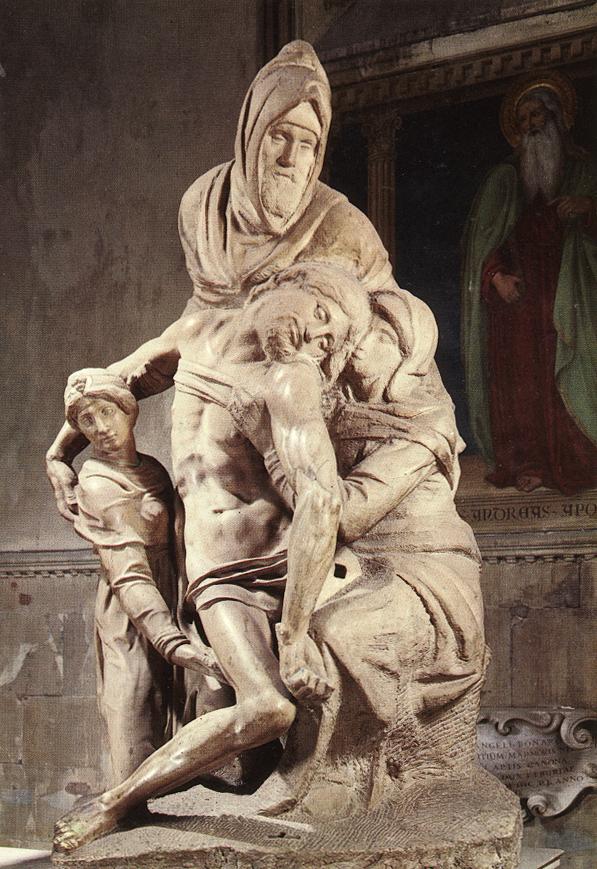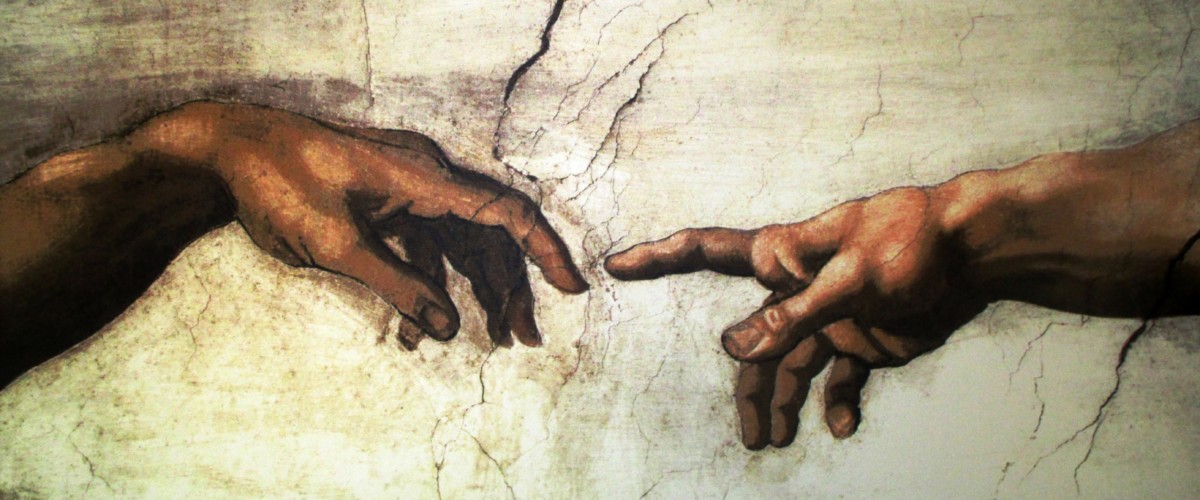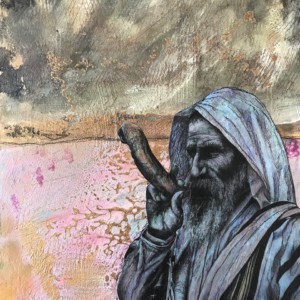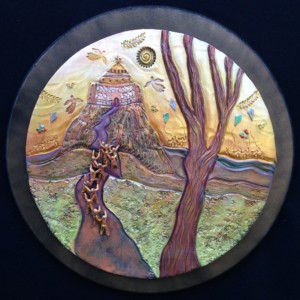I have taught Art History on the collegiate level for 45 years. I didn’t do my graduate studies in Art History; in fact, as a student, it bored me. But when I was hired on as a new professor back in 1971, I was the low man on the totem pole, so I was given the classes that no one else wanted to teach. One of those classes was Art History. What happened over the next 45 years was a surprise to me. I fell in love with Art History, and it actually became one of the best classes that I taught.
I will be posting things from time to time that deal with artistic historical subjects. Why am I doing this? Because anyone who is an artist will become a better artist when they know Art History. Also, artists of past eras are part of the great cloud of witnesses that the book of Hebrews talks about, but unfortunately, most people in the church know nothing about them.
For my first entry on Art History, I am going to talk about a man who is arguably the greatest artist who ever lived, Michelangelo. This will be a 2-part series. The first will be on his spiritual life, which I think will surprise everybody. The second entry will deal with the art theories of Michelangelo, which are quite unique. If you think you know Michelangelo, my guess is you really don’t. I believe what follows will be a real inspiration to believers who love art, and you will not find this stuff in your typical Art History book. So here goes.
MICHELANGELO PART 1: HIS SPIRITUAL LIFE.
We live in an age where much of the past is being rewritten by people who are trying to revise history through the lens of our age. When one does this, it changes history. Michelangelo was one of the most devout men of the entire Renaissance—lay or cleric. Yet if you read articles about him that are published today, what they will emphasize is his “undoubted” homosexuality and his violent temper. I will address these issues soon, but these issues are highly exaggerated by certain groups who are looking for “heroes” that will justify their causes.
Many people do not realize that Michelangelo was also a fine poet, and he left behind many letters and poems that give us insight into the real Michelangelo. In his late poetry, he hails the blood of Christ as the agent of his own hoped-for redemption, and it is impossible to overemphasize his own religious fervor. It was something heartfelt and compelling which came to him early in life and stayed until death. His conviction was uncompromising. He went often to hear the radical theologian Savonarola preach and was greatly influenced by him. Savonarola preached a message of turning away from sin and repentance, and he railed against the vanities that were so apparent everywhere in Florence at this time. He preached purity of heart and was burned at the stake for his efforts.
Michelangelo believed in prayer. Writing to his nephew, he affirmed that he had greater trust in prayer than in medicines. A prayer found in in Michelangelo’s papers reads thus: “Give me grace, that so long as I shall stay in this prison unfriendly to my soul [his body] in which thou alone does hold me, I may exalt thee.” The poet Rilke correctly views Michelangelo’s dedicated artistic power as a form of prayer.
Michelangelo’s intense faith was the primary cause of the greatness of his work. His faith did more than affect the nature of his work—it affected his very thinking on the origin and function of art. Several of his statues portray the struggle of the individual to free himself from matter. He believed that, second only to man, marble was God’s greatest creation and that within each block of marble, there was a figure that God had placed; the job of the sculptor was to release that figure, much like at death our bodies will release our souls.
Michelangelo knew the leading minds in the Renaissance and was tutored as a young man by the most renowned scholars of his era who taught him not only the most recent Neo-Platonic theories but also engaged him in Jewish thought, especially the Midrash, Talmud, and the Kabbalah. These words are not familiar to most of my readers, so here is the short version. Neo-Platonism was a quasi-religious philosophy that combined the centrality of man (humanism) and man’s beauty with pagan ideas, Christian ideas, and Jewish thought with the idea that there is a universal truth that can be found in all religions. Thus, a pagan Greek Goddess represents the same thing as the Virgin Mary—God was saying the same thing in two different ways.
The Midrash was a collection of stories, legends, and biblical commentaries from the hands of different scholars which were a part of an oral tradition going back many centuries. Unlike the Talmud, Midrash is more interested in theology than law, concepts rather than commandments. The Talmud spoke to humanity’s mind, but the Midrash spoke to its soul.
The Kabbalah was made up of secret and mystical traditions of Judaism and is supposed to have its origins in the secrets the angels dared to transmit to Adam. Kabbalah literally means “received.” This was only taught to those who were “mature” enough to receive its hidden knowledge. One of the major premises of Kabbalah is that beneath the surface of every object are hidden “emanations” (or messages) from God. All this is to say that Michelangelo was deeply affected by Jewish thought and the Neo-Platonism of his environment, especially early in life. Later he would reject much of this teaching, but what he would retain is the idea that hidden messages underneath are more important than the images on the surface. In fact, he said it was the goal of an artist to “Hide truth under 1000 fictions”. Picasso said that art is a lie that tells us the truth; Jesus said He spoke in parables to ‘hide the truth of the Kingdom.’ Go figure!
As mentioned earlier, the priest from San Marco, Savonarola, was one of his greatest influences. In fact, Michelangelo almost became a friar in Savonarola’s order. He was also influenced by the Spaniard Ignatius Loyola and he even volunteered to build the church for the Order of the Society of Jesus (the Jesuits). Michelangelo consecrated his life to his faith. He held a strong conviction that he could serve God best with his chisel and brush. In the last 17 years of his life, he became the director for the building of the Vatican and designed the famous dome (which he never saw finished), and he did this without pay and, instead, did it “for the love of God.”
Although deeply religious, he didn’t support the officials of the church blindly. He didn’t see the Pope as infallible. He believed that whether one was a Pope, cardinal, bishop, priest, or painter, they were all servants of God, and it was up to each one individually to serve God in both excellence and morality of living. In fact, every time Michelangelo included his own self-portrait in a work, it was always in the role of a saint, which demonstrated autobiographical identification.
So what did he think of Protestantism? He approved of critics within the church like Savonarola, and he wished for reforms. He believed in justification through the blood of Christ which was preached by Luther, but his loyalty to the Roman Church could not admit to schisms.
Michelangelo believed that God created all beauty and then endowed a certain minority of artists with a talent for finding that beauty. He called this “Intelletto.” He also believed that the ability to paint rapidly was a gift “received from the immortal God.” “In my judgement, excellence and divine painting is that which most resembles and best imitates some work of the immortal God.” By this, Michelangelo meant reality in its ideal form (how it was in the mind of God as He first intended it). He also believed that “painting comes from heaven and God is the original artist.”
On Morality and Art
His thoughts on the painting of nudes: “Who has such barbarous judgement that he does not understand that a man’s foot is more noble than his shoe, his flesh more noble than the the sheep skin from which his clothing is made?” God’s most noble subject matter was the human body, made in His image.
Michelangelo was alert to the moral or immoral nature and its effect upon art. He found that the greatest purpose and justification of art was to inspire pious (religious) feelings in the spectator. He said that religious art was the prayer book for the illiterate. His Sistine Chapel paintings were understood as “sermons in paint” and were not meant simply for their beauty. Leonardo DaVinci felt that art was also the prayer book for literate men since the images would evoke thoughts that the printed page could not (a picture is worth a thousand words). Michelangelo felt that since painting is a “copy of the perfections of God and a remembrance of His painting,” therefore, “painting is predestined to inspire devotion among the onlookers.”
Michelangelo portrayed generalized, non-realistic features on his figures. The reason for this was his desire to achieve a universal idealism. He felt that to portray actual likenesses of his models was a sacrilege. Savonarola said, “Idealize so that no one will genuflect before a Madonna only to discover later that it was the fishmongers daughter.”
Michelangelo said that one may portray God and the saints provided that, first, he was a master of his craft. Secondly, that he idealizes the portrait. Thirdly, he has the power to evoke feelings of piety from his audience. Fourthly, that he is a person of an unimpeachable moral character himself. He felt that moral character was a pre-requisite to an artist engaging in religious art.
Michelangelo notes that “when God inspired the making of the Ark and Temple, He took pains to insure the quality of craftsmanship. They needed to be masters of their craft. They needed to be touched by grace, wisdom and intelligence from His Spirit. So if the Ark was given such gravity, how much more should He demand of those who are asked to paint pictures of His Son?” He said an artist who wishes to possess “intelletto” must remain a good Christian. “The painter cannot move us if he does not feel beforehand in his soul those emotions or feelings which he would instill in the soul of others.” You can’t give away what you don’t have. “The more moral an artist is, the less his spirit will be troubled, and the greater will be the resulting work.” I maintain that it is necessary for an artist to lead a very good life, even saintly, if he can, so that the Holy Spirit may inspire his “intelletto.”
Savonarola said, “All artist’s work bear the stamp of their thoughts. Carnal and debauched men are the enemies of the fine arts.” A Renaissance priest named Beecher said, “Every artist dips his brush in his own soul and paints his own nature into his pictures.” Picasso said, “Painting is just another way of keeping a journal.”
Michelangelo’s Moral Life
Michelangelo was moderately heterosexual and was not libidinous. He entertained powerful feelings for both men and women, but these affections he tried to sublimate or idealize. This might be a good time to explain a few things about Neo-Platonism that affected the way Michelangelo saw the world.
In Neo-Platonism, the contemplation of beauty was the surest way of drawing close to God, who authored all beauty. The culmination of God’s creation was man. Man was the only thing that God described as very good, and we were made in His image. Michelangelo longed to draw close to God. So the idea was that by contemplating the most beautiful thing that God created which was man (not woman in the medieval mind), a person could become close to his Maker.
Michelangelo said, “God, the Supreme Artist, reveals Himself in the mortal veil of man. Nor does God, in His grace, show himself to me in any other aspect more clearly than in a beautiful human veil.” Hence, by contemplating the nude figure of a beautiful man, you were by extension being drawn closer to God. This idea seems foreign to us now, but it was considered truth by the leading intellectuals of Michelangelo’s age. This is why Michelangelo even used male models for his sculptures of women. This is why he wrote love poems to beautiful men. This is about Platonic love, not physical love. Yet this is never mentioned today when people write about Michelangelo because our century embraces the revisionist history that fits our worldview.
All of his life, Michelangelo tried to reconcile Greek thought with Christian thought. As an example, the religious imagery on the Sistine Chapel ceiling is based upon solid theology, but the forms are those of pagan gods or in the sculpture of Duke Giuliano fingering his baton as captain of the church while garbed in Roman costume. In fact, in the Sistine ceiling, Old Testament prophets are pictured alongside pagan sybils (prophets). By adopting classical themes, he could indulge more easily his love for the human body, which was rejected in the Medieval culture.
Michelangelo begrudged any sexual activity, claiming that it drained off energies which might otherwise be used for art. He admits that he lived for beauty and adds, “If anyone thinks otherwise, his opinion is wrong.” His late poetry revealed that his anguish over earthly love was just as racking as the torments of his love of God.
As he grew older, his soul-searching was intensified. He urged Christ not to raise up His arm and point to the blemishes of the past. “Let not your holy eyes look righteously upon my past; nor your chaste ear attend it; raise not toward it [his past] your severe arm.” “Lord, in the last hours stretch towards me thy forgiving arms, withdraw me from myself and make me one who may please you.” Again, “I live in sin, I live dying unto myself: nor yet even a life of my own, but of sin. My grace was given of heaven, my evil of myself, my will dissolved, ‘free will’ I have no more.” Statements like this reveal the intensity of his morality rather than his immorality.
During his lifetime, he was universally called the “Divine Michelangelo” by his contemporaries, but this did not refer exclusively to his artistic talent. It reflected also his moral character. Like Vincent Van Gogh, Michelangelo practiced self-imposed sufferings and asceticisms in pursuit of purity and holiness.
After 1534, with the exception of his portrait of Brutus, there is not one secular theme in either his poetry or his art. By that time, he had given himself wholly to Christian themes. No longer was there a dualism in his work. This was most likely due to his association with a widow and poet named Vittoria Colonna who introduced him to a secret but highly influential group called the “Fifth Column” whose sole goal was to reform the Vatican and the Catholic Church.
They spoke out against the abuses of power and hypocrisy of the Vatican and they wanted the Scriptures to be open and available to all people. Many of their reforms were very much aligned with Protestantism, except they wanted to reform the church from within and ultimately harmonize Protestant and Catholic beliefs in order to bring about a church unified, cleansed, and reborn. The Council of Trent finally put an end to this, and the sad results of that Council are evident in the final split of the Christian Church.
Michelangelo had his flaws as do all of us. But I hope the reader can see that he was a remarkable man who truly was a strong believer and, in my mind, the greatest artist to walk the face of the earth. In closing, let me leave the reader with this: Michelangelo understood that great art should express beauty, but he felt that the aim of that beauty was to awaken the soul to the contemplation of God and His goodness.
Before you part, I would like to mention something about the art that I chose to accompany this post. The work is titled “The Deposition” and was one of the last sculptures he was working on before he died. He intended it to be placed over his grave. It lacks the high polish of his earlier work, and this was intentional. One of his last recorded words were “I regret only two things: First, that I have not done enough for the salvation of my soul and second, that I am dying just as I am beginning to learn the alphabet of my trade.” So instead of trying to wow people with his skills, he softened the sculpture with textures to create a poetic effect.
“Deposition” means “the taking down from the cross.” What is most interesting here is that Nicodemus, who is holding Jesus, was a secret follower of Christ but, in the end, was bolder than the disciples by being with Jesus at the finish. The face of Nicodemus is Michelangelo’s self-portrait, for he, too, was a follower of Christ, and he wanted the world to know.

Featured Image by Pixabay
In-Text Image by Wiki Art















That was so good!
I’m a Christian myself and an artist too (beginner)
I admire him and The Statue of David ever since I’ve learned the history and
the intention of the artist while making it.
Learning about his beliefs make me love jim even more.
Although I don’t wholly believe in his beliefs,
I like how he interpreted the scriptures.